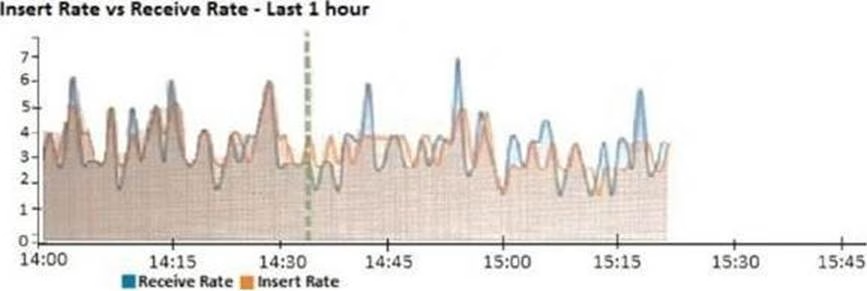Fortinet FCP_FAZ_AN-7.4 Fortinet FCP – FortiAnalyzer 7.4 Analyst Online Training
Fortinet FCP_FAZ_AN-7.4 Online Training
The questions for FCP_FAZ_AN-7.4 were last updated at Apr 07,2025.
- Exam Code: FCP_FAZ_AN-7.4
- Exam Name: Fortinet FCP - FortiAnalyzer 7.4 Analyst
- Certification Provider: Fortinet
- Latest update: Apr 07,2025
Which statement about the FortiSIEM management extension is correct?
- A . It requires a licensed FortiSIEM supervisor.
- B . Its use of the available disk space is capped at 50%.
- C . It can be installed as a dedicated VM.
- D . Allows you to manage the entire life cycle of a threat or breach.
View the exhibit.

What does the data point at 14:35 tell you?
- A . FortiAnalyzer is dropping logs.
- B . The sqlplugind daemon is ahead in indexing by one log.
- C . FortiAnalyzer has temporarily stopped receiving logs so older logs’ can be indexed.
- D . FortiAnalyzer is indexing logs faster than logs are being received.
What is the purpose of employing RAID with FortiAnalyzer?
- A . To introduce redundancy to your log data
- B . To provide data separation between ADOMs
- C . To separate analytical and archive data
- D . To back up your logs
What is the main purpose of deploying RAID with FortiAnalyzer?
- A . To back up your logs
- B . To make an identical copy of log data on two separate physical drives
- C . To provide redundancy of your log data
- D . To store data in chunks across multiple drives
In order for FortiAnalyzer to collect logs from a FortiGate device, what configuration is required? (Choose two.)
- A . Remote logging must be enabled on FortiGate
- B . FortiGate must be registered with FortiAnalyzer
- C . Log encryption must be enabled
- D . ADOMs must be enabled
After you have moved a registered logging device out of one ADOM and into a new ADOM, what is the purpose of running the following CLI command?
execute sql-local rebuild-adom <new-ADOM-name>
- A . To reset the disk quota enforcement to default
- B . To remove the analytics logs of the device from the old database
- C . To migrate the archive logs to the new ADOM
- D . To populate the new ADOM with analytical logs for the moved device, so you can run reports
For proper log correlation between the logging devices and FortiAnalyzer, FortiAnalyzer and all registered devices should:
- A . Use DNS
- B . Use an NTP server
- C . Use real-time forwarding
- D . Use host name resolution
What must you consider when using log fetching? (Choose two.)
- A . The fetch client can retrieve logs from devices that are not added to its local Device Manager.
- B . You can use filters to include only logs from a single device.
- C . The fetching profile must include a user with the Super_User profile.
- D . The archive logs retrieved from the server become archive logs in the client.
What happens when the IOC breach detection engine on FortiAnalyzer finds web logs that match a blocklisted IP address?
- A . The endpoint is marked as Compromised and. optionally, can be put in quarantine.
- B . FortiAnalyzer flags the associated host for further analysis.
- C . A new Infected entry is added for the corresponding endpoint.
- D . The detection engine classifies those logs as Suspicious
Which two statements are true regarding ADOM modes? (Choose two.)
- A . You can only change ADOM modes through CL
- B . In normal mode, the disk quota of the ADOM is fixed and cannot be modified, but in advance mode, the disk quota of the ADOM is flexible because new devices are added to the ADO
- C . In an advanced mode ADOM, you can assign FortiGate VDOMs from a single FortiGate device to multiple FortiAnalyzer ADOMs.
- D . Normal mode is the default ADOM mode.
Latest FCP_FAZ_AN-7.4 Dumps Valid Version with 150 Q&As
Latest And Valid Q&A | Instant Download | Once Fail, Full Refund

